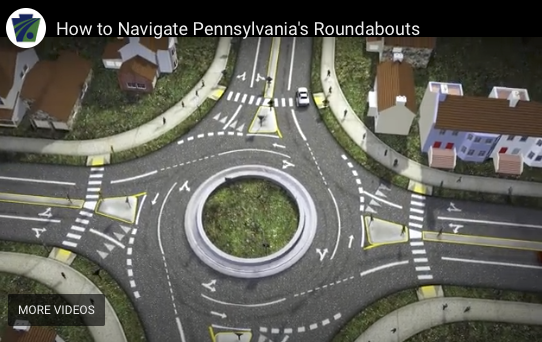This could depend on your definition of 'safer' - fewer accidents, or fewer injuries/deaths.
If you watch YooToob's 'dash cam' compilations, you quickly spot that Americans can't use traffic lights & Brits can't use roundabouts. What you will also see is the enormous difference in how serious the results are.
By their very nature, many of these videos use the most spectacular footage they can find, which makes them a biased view; but of the ones who concentrate on US footage, the sheer number & carnage resulting from 40mph+ T-bones & 'turning left against a straight-through light' incidents is remarkable. [No-one asked for my opinion, but I actually think this is a result of having the traffic lights so high up, well out of the natural sightline.]
Comparatively, the British roundabout incidents are often someone changing lanes foolishly, or entering when unsafe. These usually result in either some heavy braking & horn blowing, or some dented metalwork. They don't end in lamp posts & telegraph poles down, cars spun right off the road in tangles of twisted metal.
By my definition, that already makes roundabouts 'safer'. There are fewer deaths and serious injuries.
One thing we have in the UK is a lane system, where if you start in the correct lane, you will naturally be fed out into the correct exit. This can make a huge difference in big roundabouts, where you can't even see your exit from the entrance. This one is small enough that you can see how the lanes work from a drone photo. This only qualifies as a medium-large roundabout. We have them a whole lot bigger.*
If you start in the right-hand lane [up at the top of the pic] to turn right, then without crossing any lanes except in the initial entry phase [which is also helped by shorter white markings], then you are fed out to the correct exit.
Not all large roundabouts have this system. The ones that don't are far more hazardous to negotiate, even for one practised at the British structure.
From the OP's PennDoT link - this is how not to lane a roundabout.
There are too many areas of 'guesswork' if both lanes are used simultaneously. With this method you only need one idiot in the outside lane trying to turn left for it to quickly become chaos. [This is reminiscent of what I've seen in Spain, where half the drivers stay in the outside lane, no matter where their exit might be. You need eyes in the back of your head to negotiate one of those. It is one of those times where the 'bad' behaviour actually becomes safer, and so often you'll see everybody going round the outside, leaving the inside empty & effectively treating it as though it had no lanes & was just a single-track system.
In the UK a modern roundabout this small wouldn't be laned at all which makes everyone treat it as a single lane & follow rather than try to drive side-by side… mimicking the Spanish system, but officially. If it was laned, as older roundabouts tended to be, then it's a single dotted line right the way round, but with no other messages. That's why they're doing away with lanes on the smaller ones, it removes a lot of dangerous guesswork.
*Bigger roundabouts - I've never measured it but this one might be a mile round, under & over two motorways. We don't really do clover-leaf junctions so much in the UK. This one has great laning right round, except for one exit which makes it a nightmare. [On the right in this pic, but the pic is of an earlier laning structure, since replaced & easier to see] btw, they must have taken this photo at 8am on a Sunday, it's never this quiet ;)



